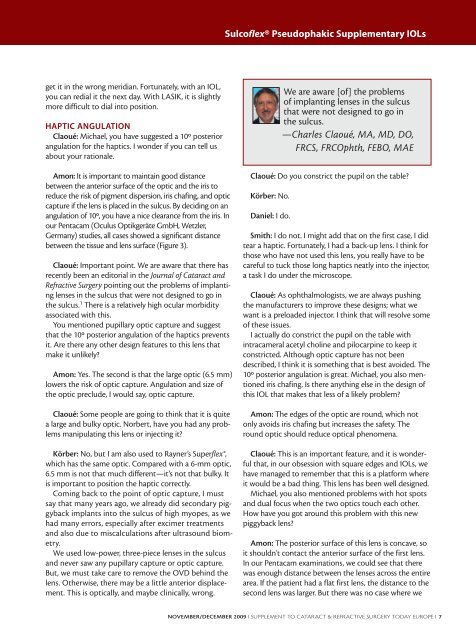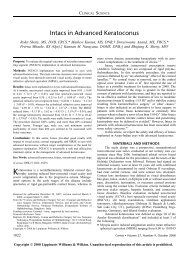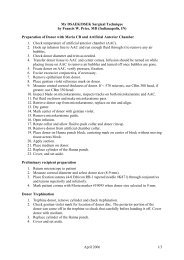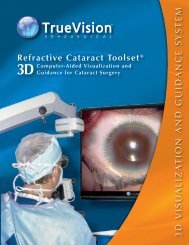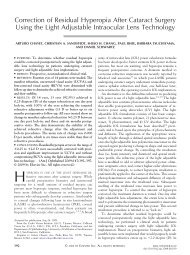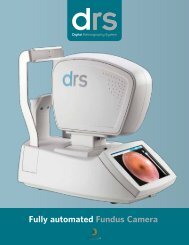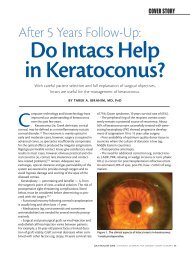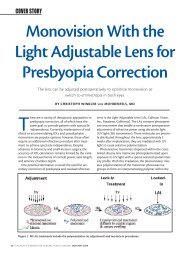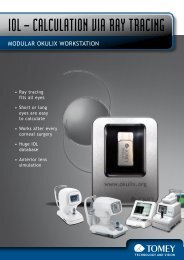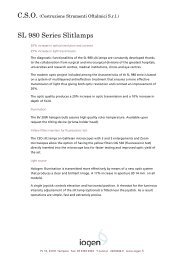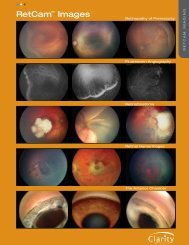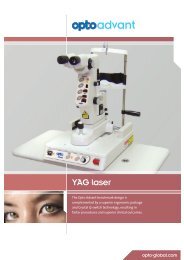Sulcoflex ®Pseudophakic Supplementary IOLs - Iogen
Sulcoflex ®Pseudophakic Supplementary IOLs - Iogen
Sulcoflex ®Pseudophakic Supplementary IOLs - Iogen
You also want an ePaper? Increase the reach of your titles
YUMPU automatically turns print PDFs into web optimized ePapers that Google loves.
get it in the wrong meridian. Fortunately, with an IOL,<br />
you can redial it the next day. With LASIK, it is slightly<br />
more difficult to dial into position.<br />
HAPTIC ANGULATION<br />
Claoué: Michael, you have suggested a 10º posterior<br />
angulation for the haptics. I wonder if you can tell us<br />
about your rationale.<br />
Amon: It is important to maintain good distance<br />
between the anterior surface of the optic and the iris to<br />
reduce the risk of pigment dispersion, iris chafing, and optic<br />
capture if the lens is placed in the sulcus. By deciding on an<br />
angulation of 10º, you have a nice clearance from the iris. In<br />
our Pentacam (Oculus Optikgeräte GmbH, Wetzler,<br />
Germany) studies, all cases showed a significant distance<br />
between the tissue and lens surface (Figure 3).<br />
Claoué: Important point. We are aware that there has<br />
recently been an editorial in the Journal of Cataract and<br />
Refractive Surgery pointing out the problems of implanting<br />
lenses in the sulcus that were not designed to go in<br />
the sulcus. 1 There is a relatively high ocular morbidity<br />
associated with this.<br />
You mentioned pupillary optic capture and suggest<br />
that the 10º posterior angulation of the haptics prevents<br />
it. Are there any other design features to this lens that<br />
make it unlikely?<br />
Amon: Yes. The second is that the large optic (6.5 mm)<br />
lowers the risk of optic capture. Angulation and size of<br />
the optic preclude, I would say, optic capture.<br />
Claoué: Some people are going to think that it is quite<br />
a large and bulky optic. Norbert, have you had any problems<br />
manipulating this lens or injecting it?<br />
Körber: No, but I am also used to Rayner’s Superflex®,<br />
which has the same optic. Compared with a 6-mm optic,<br />
6.5 mm is not that much different—it’s not that bulky. It<br />
is important to position the haptic correctly.<br />
Coming back to the point of optic capture, I must<br />
say that many years ago, we already did secondary piggyback<br />
implants into the sulcus of high myopes, as we<br />
had many errors, especially after excimer treatments<br />
and also due to miscalculations after ultrasound biometry.<br />
We used low-power, three-piece lenses in the sulcus<br />
and never saw any pupillary capture or optic capture.<br />
But, we must take care to remove the OVD behind the<br />
lens. Otherwise, there may be a little anterior displacement.<br />
This is optically, and maybe clinically, wrong.<br />
<strong>Sulcoflex</strong>® Pseudophakic <strong>Supplementary</strong> <strong>IOLs</strong><br />
Claoué: Do you constrict the pupil on the table?<br />
Körber: No.<br />
Daniel: I do.<br />
We are aware [of] the problems<br />
of implanting lenses in the sulcus<br />
that were not designed to go in<br />
the sulcus.<br />
—Charles Claoué, MA, MD, DO,<br />
FRCS, FRCOphth, FEBO, MAE<br />
Smith: I do not. I might add that on the first case, I did<br />
tear a haptic. Fortunately, I had a back-up lens. I think for<br />
those who have not used this lens, you really have to be<br />
careful to tuck those long haptics neatly into the injector,<br />
a task I do under the microscope.<br />
Claoué: As ophthalmologists, we are always pushing<br />
the manufacturers to improve these designs; what we<br />
want is a preloaded injector. I think that will resolve some<br />
of these issues.<br />
I actually do constrict the pupil on the table with<br />
intracameral acetyl choline and pilocarpine to keep it<br />
constricted. Although optic capture has not been<br />
described, I think it is something that is best avoided. The<br />
10º posterior angulation is great. Michael, you also mentioned<br />
iris chafing. Is there anything else in the design of<br />
this IOL that makes that less of a likely problem?<br />
Amon: The edges of the optic are round, which not<br />
only avoids iris chafing but increases the safety. The<br />
round optic should reduce optical phenomena.<br />
Claoué: This is an important feature, and it is wonderful<br />
that, in our obsession with square edges and <strong>IOLs</strong>, we<br />
have managed to remember that this is a platform where<br />
it would be a bad thing. This lens has been well designed.<br />
Michael, you also mentioned problems with hot spots<br />
and dual focus when the two optics touch each other.<br />
How have you got around this problem with this new<br />
piggyback lens?<br />
Amon: The posterior surface of this lens is concave, so<br />
it shouldn’t contact the anterior surface of the first lens.<br />
In our Pentacam examinations, we could see that there<br />
was enough distance between the lenses across the entire<br />
area. If the patient had a flat first lens, the distance to the<br />
second lens was larger. But there was no case where we<br />
NOVEMBER/DECEMBER 2009 I SUPPLEMENT TO CATARACT & REFRACTIVE SURGERY TODAY EUROPE I 7


